Bromodomain and extra-terminal inhibitors emerge as potential therapeutic avenues for gastrointestinal cancers
INTRODUCTION
Gastrointestinal (GI) cancers,including colorectal cancer (CRC),liver cancer,gastric cancer (GC) and pancreatic cancer,are among the most common malignancies worldwide with high incidence and mortality rates.In the latest global cancer data of 2020,CRC is the second leading cause of cancer death (9.4% of the total cancer deaths),followed by stomach cancer (8.3%),liver cancer (7.7%) and pancreatic cancer (4.6%)[1].Surgery still remains the only curative treatment for GI cancers[2].However,most patients are diagnosed as GI cancer at advanced stages or metastases,and thus lose the chance of surgery.Several therapies including chemotherapy[3,4],radiotherapy[5],chemoradiotherapy[6] and immunotherapy[7,8],have been developed for those GI cancers patients who are intolerable to operation.Unfortunately,inevitable toxicity[9],innate or acquired chemo-resistance[10] and low response[11] limit the clinical use of these treatments,highlighting the need for developing new therapeutic strategies.
Bromodomain and extra-terminal (BET) protein inhibitors emerge as a new therapeutic avenue for multiple cancers,including GI cancers.BET inhibitors exert anti-cancer activities by competitively binding to BET proteins and disrupting the interaction between BET proteins and acetylated lysines.Increasing studies have reported that upregulation of BET proteins leads to abnormal transcriptional regulation[12],which facilitates tumor initiation and progression.Down-regulation of BET proteins expression and inactivation of their function represent a possible mechanism of anti-tumor effect of BET inhibitors.Therefore,BET inhibitors present to be a rational strategy for the sake of GI cancers treatment.Several BET inhibitors targeting the BET bromodomains (BD) are currently under clinical investigations and preclinical data provides rationale for the use of BET inhibitors in treating GI cancers.
In this review,we will briefly describe the structure and inhibition mechanism of BET proteins and illustrate the role of BET proteins in the initiation and progression of human GI cancers.Then,we will identify whether targeting BET proteins,alone or in combination with other therapies,exhibits potential benefits in GI cancers through preclinical evidence.Finally,we will speculate the outlook of the translation of BET inhibitors into clinic.
Presently the old witch sat down to supper and Vasilissa brought all she had cooked, enough for five grown men, and set it before her, and brought beer and honey, and then she herself stood silently waiting. The Baba Yaga ate and drank it all, every morsel, leaving not so much as a crumb38 of bread; then she said snappishly: Well, why dost thou say nothing, but stand there as if thou wast dumb?
BET PROTEINS:STRUCTURE AND INHIBITION MECHANISM
BET family proteins include four subtypes:BRD2 (also known as FSRG1,RING3,RNF3,FSH,or D6S113E),BRD3 (also known as ORFX or RING3L),BRD4 (also known as MCAP or HUNK1) and BRDT (also known as BRD6,CT9,or SPGF21)[13,14].Each of the BET proteins has a highly conversed structure including two tandem-110 amino acid bromodomains (BD1 and BD2) with direct specificity for acetylated lysines,followed by an extra-terminal (ET) protein-protein interaction domain[15].Notably,BRD4 and BRDT comprise a C-terminal domain,which functionally recruits transcriptional regulators,like the positive transcription elongation factor b (P-TEFb)[16,17](Figure 1).The similarity and difference in structure among BET proteins may partly interpret the parallel and differential function in human disease,especially in cancer.
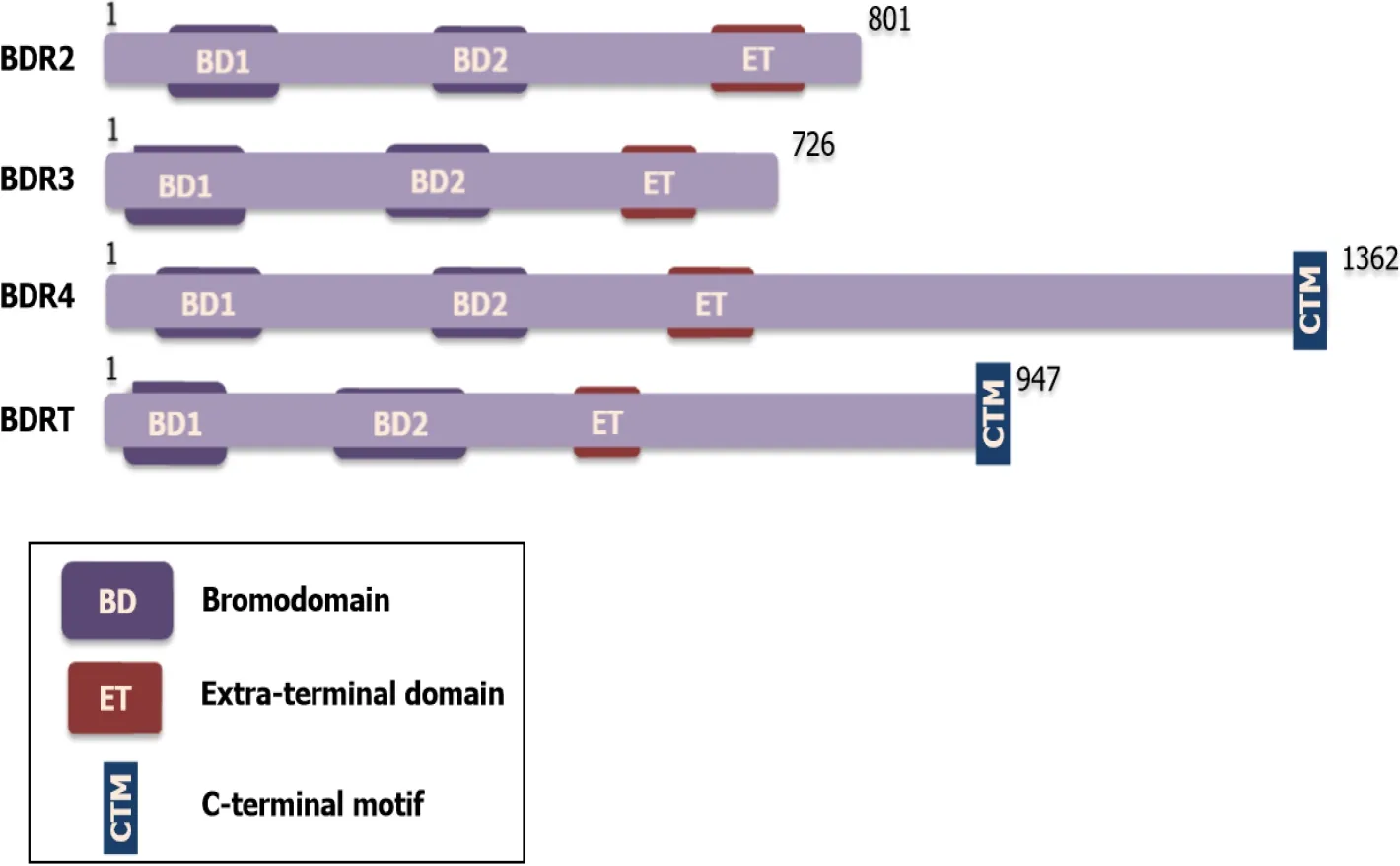
AZD5153 is a novel BRD4 inhibitor,effecting Mus81 down-regulation and suppressing tumor migration in GC[76].A Phase I study was initiated to evaluate the safety,pharmacokinetics,and pharmacodynamics of AZD5253 alone or in combination with Olaparib in patients with malignant solid tumors,including pancreatic cancer.The recruiting status of this study remains active,not recruiting (NCT-03205176).
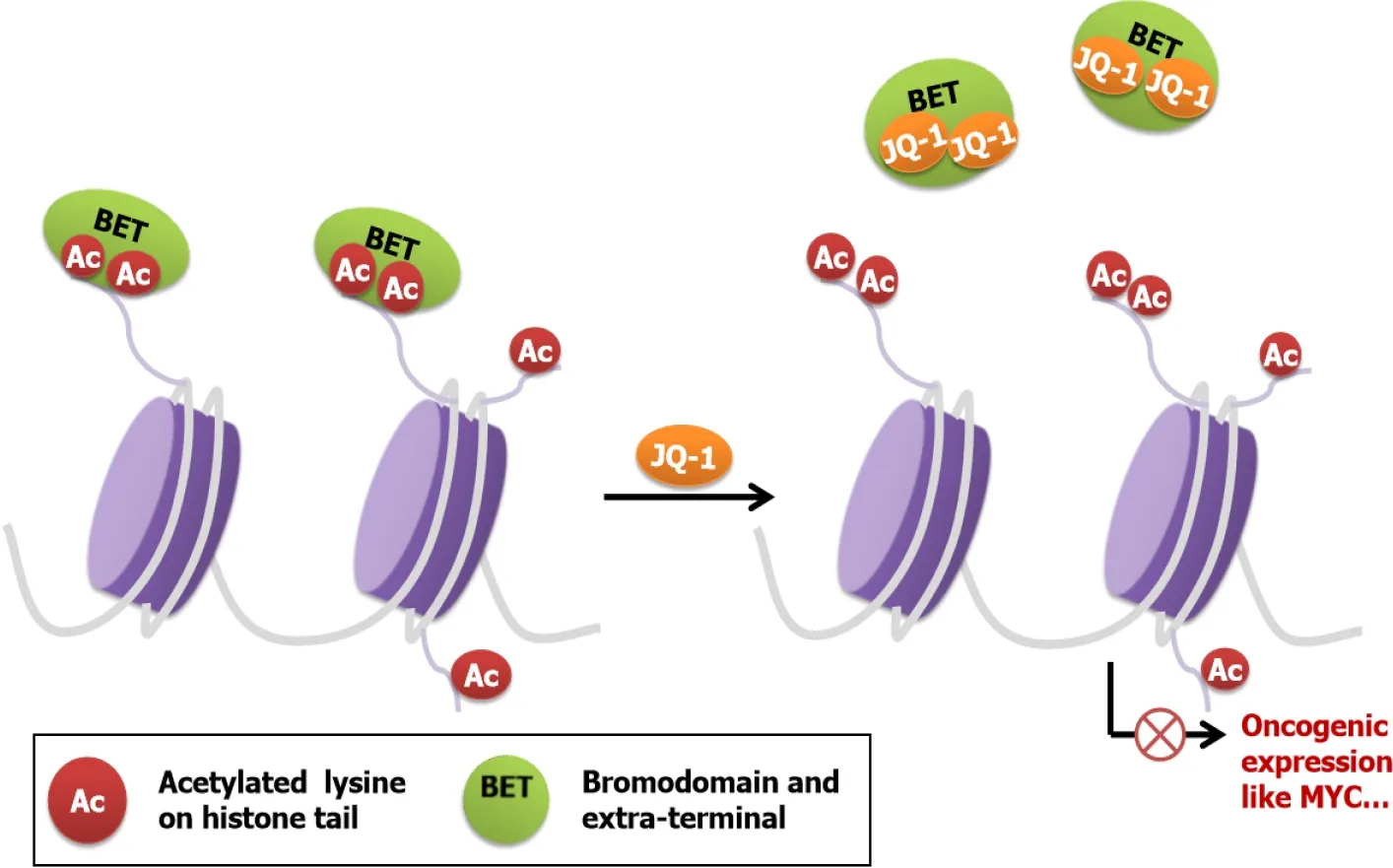
BET PROTEINS IN GI CANCERS
Oncogenic roles of BET proteins family were firstly revealed in the NUT carcinoma.BRD4 and BRD3 are involved in the chromosomal rearrangements of NUT carcinoma by forming BET-NUT fusion protein[19].The inspirational discovery that BET proteins serve as potential cancer therapeutic targets encourages researchers to look for possible functions of BET proteins in other cancers,including GI cancers.Strikingly,BET proteins (BRD2,BRD4) are overexpressed in GI cancers and have been reported to promote GI cancers progressionmultiple mechanisms.
Preclinical data demonstrated that BET inhibitors alone had exhibited efficacy against CRC by inhibiting tumor growth and inducing apoptosisand[27,45].However,resistance to BET inhibitors was the major obstacle to CRC treatment.Wang[46] raised one possible mechanism that the interaction of STAT3 through BRD4 phosphorylation might result in the resistance of BET inhibitors in CRC.Combining BET inhibitors and other targeted therapies could help to overcome resistance and render CRC more sensitive to BET inhibitors.For example,nuclear factor-kappa B inhibitors[47],PI3K/mTOR inhibitors[40],HDAC3 inhibitor[48] have been reported to sensitize GI cancers to BET inhibitors,and finally achieve synergistical effects.
Some people are just doomed1 to be failures. That s the way some adults look at troubled kids. Maybe you ve heard the saying, A bird with a broken wing will never fly as high. I m sure that T. J. Ware2 was made to feel this way almost every day in school.
BRD4 is the most extensively studied BET proteins in GI cancers which is highly expressed in cancer tissues and cell lines,including CRC[27],pancreatic cancer[28],liver cancer[29],and GC[30].The overexpression of BRD4 promotes GI cancer cell growth,differentiation and metastasis,and correlates with poor outcome of GI cancers patients[31,32].On one hand,BRD4 could directly bind to the promoter region of oncogenes and induce their overexpression,including c-MYC[33],E2F2[34],caveolin-2[28],PES1[35] and CD276[36].On the other hand,BRD4 could recognize acetylated lysines on epithelial-to-mesenchymal transition (EMT)-activating transcriptional factors like Twist or Snail,the activation of which facilitated the differentiation and survival of EMT cells and promoted metastatic growth in GI cancers[27,37,38].Additionally,BRD4 was reported to be recruited to senescence-activated superenhancers to mediate cellular senescence[39].The senescent cancer cells induced the secretion of various cytokines and increased CRC cells migration and invasion abilities[40].In addition to the direct induction of tumorigenesis,BRD4 was also involved in the crosstalk between cancer and cancer-associated fibroblasts.Inhibiting the BRD4 protein changed both transcription and structure of matrisome in PDAC and resulted in better patients’ survival[41].Moreover,Yasukawa[42] also described that BRD4 played an important role in cancer associated fibroblasts in GC[42].These oncogenic functions suggest that BRD4 is an important molecular target for GI cancers.
BET INHIBITORS IN GI CANCERS
Given that BET proteins are important regulators in GI cancer,targeting BET proteins will be a good therapeutic strategy for GI cancers treatment.A series of compounds have been reported as potential therapeutic avenues for GI cancers by targeting BET proteins (Table 1).BET inhibitors share the similar mechanism by displacing BET proteins from chromatin and regulating transcriptional factors.By mediating cell cycle arrest,facilitating apoptosis,and inducing senescence,BET inhibitors functionally inhibit cell proliferation,invasion and migration in most GI cancers including CRC,pancreatic cancer,liver cancer and GC[43].Mechanically,BET inhibitors exert antitumor activity in c-MYC dependent,as well as c-MYC independent manners[44].BET inhibitors have been widely used in preclinical models,but BET inhibitors alone exhibit limited-single agent activity confronting drug resistance.Combinational therapy with chemotherapy,immunotherapy or other small molecule inhibitors may amplify the clinical outcomes in GI cancers.Herein,we review the application of BET inhibitors in GI cancers.
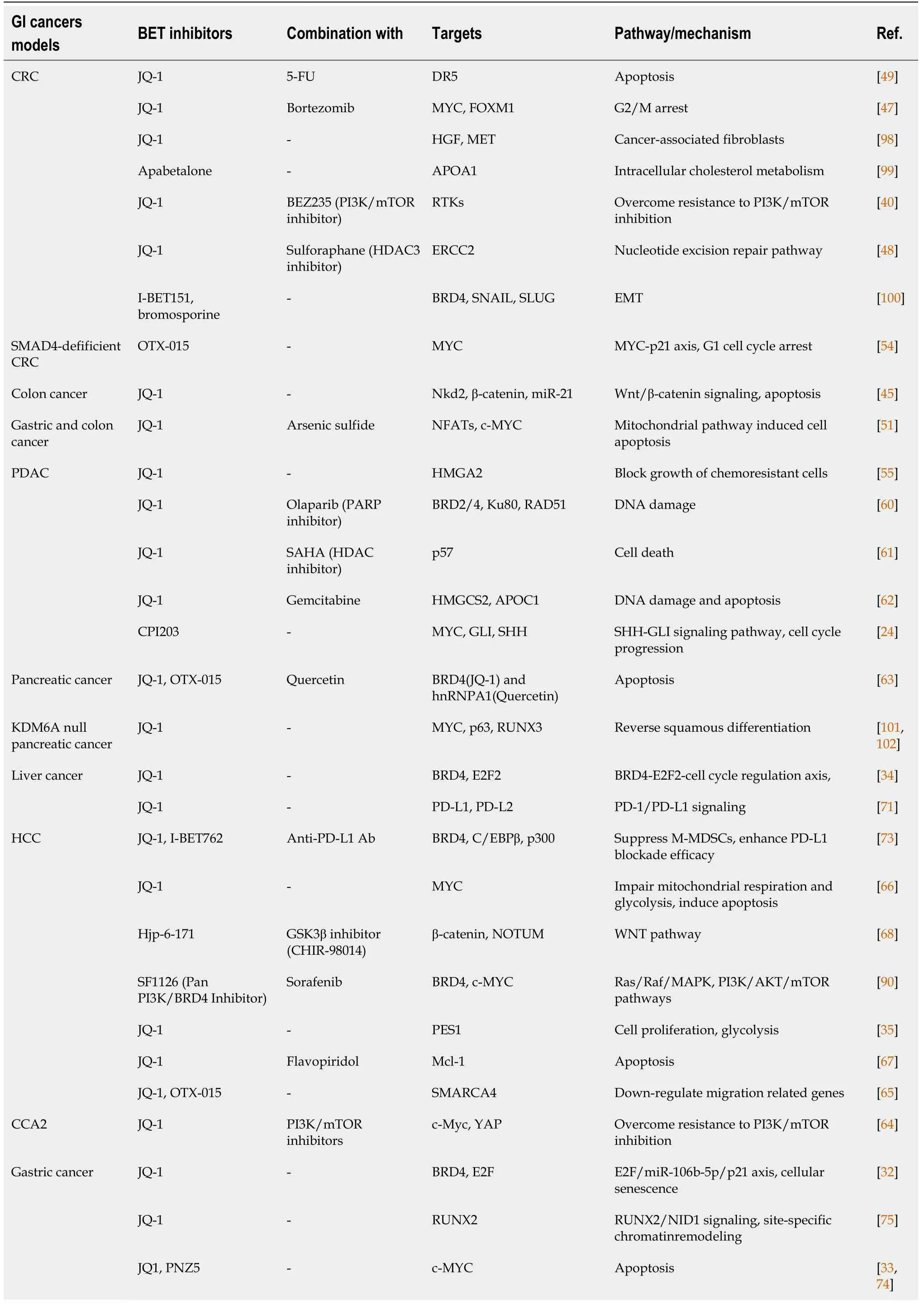

CRC
BRD2 was firstly defined as a non-canonical protein kinase[20],which could promote the GI cancers progression by recruiting transcriptional factors and initiating transcriptional regulation.Recent studies demonstrated that BRD2 promoted the progression of CRC,pancreatic ductal adenocarcinoma (PDAC) and GC[21].Specifically,BRD2 forms a complex with transcription factor ELK4 by recognizing its K125 acetyl-lysine,and then activates transcription of LAMB3 in CRC,leading to tumor growth and metastasis[22].Moreover,BRD2 drives a fibroinflammatory stromal reaction in PDAC by initiating the transcription of oncogene cellular-myelocytomatosis (c-MYC) and other stroma-inducible genes[23].Huang[24] illustrated a different pathway that BRD2 could activate the transcriptional factor GLI,which regulated the pancreatic cancer microenvironment.These findings suggest that BRD2 is a poor prognostic predictor of GI cancers.
Moreover,BET inhibition could be used in combination with chemotherapy to enhance chemotherapy effectincreasing the apoptosis induction[49].For example,BET inhibitors could increase the sensitivity of CRC cells to 5-fluorouracil[50] and Arsenic sulfide[51,52] (Figure 3).More importantly,this combination therapy could decrease the side effect of chemotherapeutic drugs[53].Moreover,BET inhibitors conferred a synthetic lethality with loss of SMAD4 in CRC cells by restoring the loss of c-MYC repression[54],suggesting that BET inhibitors were essential for the treatment of SMAD4-deficient CRC.
Pancreatic cancer
BET inhibitors not only effectively inhibited PDAC cell growth in three-dimensional collagen partly by repressing c-MYC expression,but also conducted its efficacy in a MYC-independent way by repressing the expression of FOSL1[55].However,clinical studies suggested that BET inhibitors monotherapies were not effective revenues for PDAC treatment[56].Drug resistance assumed the major responsibility for treatment failure.The main mechanism of resistance was associated with either up-regulating or stabilizing c-MYC expression.Loss of FBP1[57],afberrant expression of ADAR1[58],high levels of GLI[24] and overexpression of PES1[59] could explain the up-regulation of c-MYC in pancreatic cancer.
To improve the efficacy of BET inhibitor on PDAC,several studies evaluated the efficiency of BET inhibitors in combination with other agents.Encouragingly,BET inhibitors could synergize with other target therapy in preclinical PDAC models.For example,BET inhibitor attenuated the DNA repair through decreasing Ku80 and RAD51 proteins,and sensitized the PDAC to PARP inhibitors[60].Another team also illustrated that BET inhibitors synergizing with HDAC inhibitors enhanced the efficacy of inducing cell deathde-repressing p57[61].In addition to being combined with target therapies,BET augmented the efficiency of chemotherapeutic drugs like Gemcitabine by increasing DNA damage and apoptosis[62].Besides,BET inhibitors combined with Quercetin suppress hnRNPA1 leading to better therapeutic effect compared with monotherapy[63].
I immediately informed the dive supervisor10 of my dilemma over the communicator. His instructions were unclear due to the fact that he, along with five other divers, were all laughing hysterically11.
Liver cancer
BET inhibitors exhibit anti-tumorigenic effects on both hepatocellular carcinoma(HCC) and cholangiocarcinoma (CCA),but in different manners.JQ-1 inhibited CCA growth in a MYC-dependent way[64],while JQ-1 played its anti-tumor role in HCC by suppressing E2F2-cell cycle regulation circuit[34] or the expression of SMARCA4[65].Notably,Yin[66] stated that JQ-1 exerted more cytotoxicity on MYC-positive HCC cells than sorafenib (first-line drug for advanced HCC) by inducing more apoptosis.This team further demonstrated that EGFR signaling contributed to the JQ1 resistance by stabilizing MYC.Zhang[67] arrived at a different resistance mechanism that upregulation of Mcl-1 was a major contributor to the resistance to BET inhibitor in HCC cells.They further found that BET inhibitors,in combination with other drugs capable of down-regulating Mcl-1 had a synergic effect in human HCCLiu[68]reported another resistance mechanism and the reactivation of WNT pathway in liver cancer cells could increase the sensitivity of HCC to BET inhibitor[68].
BET inhibitor were also reported to impact the immunotherapy efficacy in HCC(Figure 4).Several studies had shown that BET inhibition could enhance anti-tumor immunitymodulating programmed cell death-ligand 1 (PD-L1) expression[69,70].Liu[71] demonstrated that JQ-1 could decrease the total mRNA and protein levels of PD-L1 in liver cancer cell lines.However,Liu[72] reported that JQ1 upregulated the expression of PD-L1 on the plasma membraneand,but did not change the total levels of PD-L1 mRNA and protein.Another study conducted by Cheng and his colleague[73] reported that I-BET762,exerted a synergistic effect with anti-PD-L1 in the HCC model leading to augment tumor infiltrating lymphocytes.Altogether,the mechanism by which BET inhibitors modulate immunotherapy is different,but the phenotypic enhancement of immunotherapy by BET inhibitors is assured.
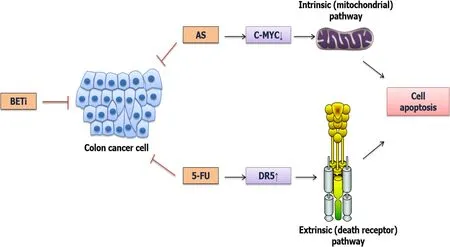
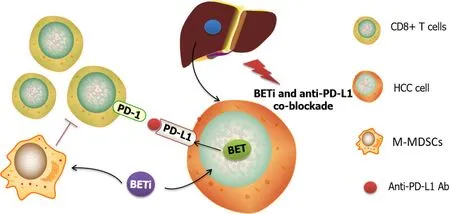
GC
You will not go to sea again, Jurgen, I suppose, observed one ofthe old fishermen. You will always stay with us now. But this was not Jurgen s intention; he wanted to see something ofthe world. The eel-breeder of Fjaltring had an uncle at Old Skjagen,who was a fisherman, but also a prosperous merchant with ships upon the sea; he was said to be a good old man, and it would not be a bad thing to enter his service. Old Skjagen lies in the extreme north of Jutland, as far away from the Hunsby dunes as one can travel in that country; and this is just what pleased Jurgen, for he did not wantto remain till the wedding of Martin and Else, which would takeplace in a week or two.
Time flew by, the king again and again begged the prince to ask some gift of him, and always received this same reply: I wish for your Majesty155 s welfare, what more can I desire? One night there was a banquet, and cupbearers carried round gold and silver cups of sparkling wine, and singers with sweetest voices contended for the prize
NEW BET INHIBITORS USING PROTAC TECHNOLOGY
Though exhibiting promising outcomes in GI cancers,BET inhibitors showed therapeutic limitations due to their reversibility,often followed by re-accumulating BET proteins and removing inhibition of c-MYC[19].This motivated new BET targeting molecules using Proteolysis Targeting Chimeras (PROTACs) technology to be invented like ARV-825 and A1874.These molecules,also called BRD4-degrading PROTACs,are heterobifunctional compounds that contain two binders with one recruiting an E3 ubiquitin ligase cereblon (CRBN) and the other targeting BRD4 proteins based on BET inhibitors.Data has shown that these molecules induce effective and selective degradation of BRD4[80] (Figure 5).The approach to target BRD4 degradation instead of inhibition resulted in more potent suppression of c-MYC as well as c-MYC-dependent genes and led to a longer-lasting effect in GI cancers.For example,Lu[81] stated that ARV-825 was superior to OTX-015 and JQ-1 in the suppression of c-MYC expression in CCA and thus exerted more inhibition on CCA cell proliferation and apoptosis.Minko[82] reported a similar anticancer activity of ARV-825 in pancreatic cancer and this activity exhibited in both 2D cell culture and 3D multicellular tumor spheroid models.Additionally,Qin[83] showed that A1874 down-regulated c-MYC,Bcl-2,and cyclin D1 in colon cancer cells and had an anticolon cancer activity by inhibiting cell proliferation,invasion and migration.Strikingly,A1874 presented to be much more effective than other BET inhibitors including JQ1 and I-BET151.However,after long-term exposure to BRD4-degrading PROTACs,resistance exists[84].Downregulating the expression of CRBN is a common mechanism of resistance.In terms of this issue,Otto[85] proposed an alternative avenue to prevent the development of resistance,which might be the use of several PROTACs to recruit different E3 Ligases.
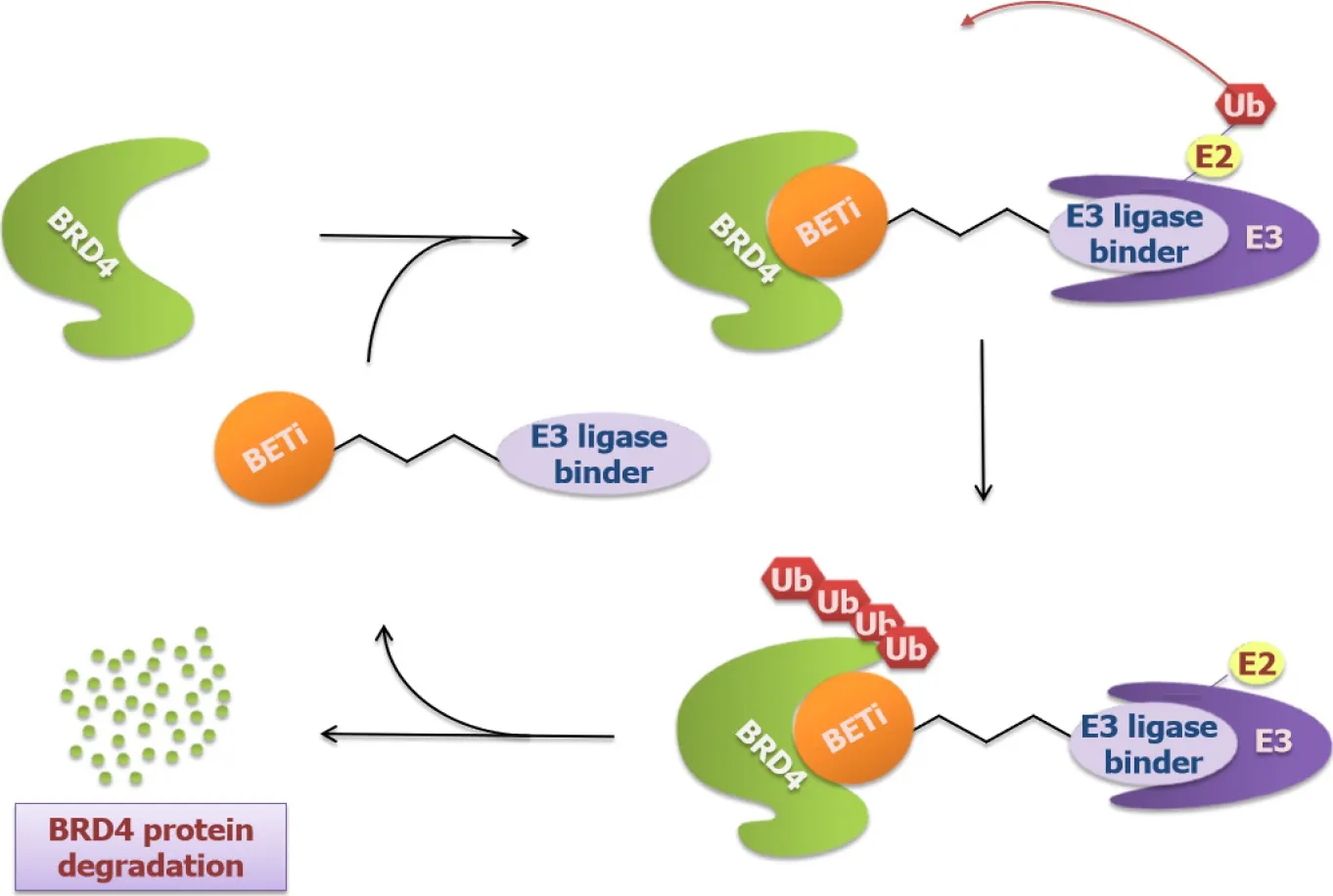
CLINICAL LANDSCAPE
BET inhibitors,including I-BET762 (NCT01587703),INCB057643 (NCT02711137),INCB054329 (NCT02431260),AZD5153 (NCT03205176) and OTX-015(NCT02698176)have entered Clinical Trial for diverse cancers[86],but the majority of them remain in the Phase I/II.Here,we are concentrating on the trials of BET inhibitors alone or in combination with other inhibitors in GI cancers (Table 2).
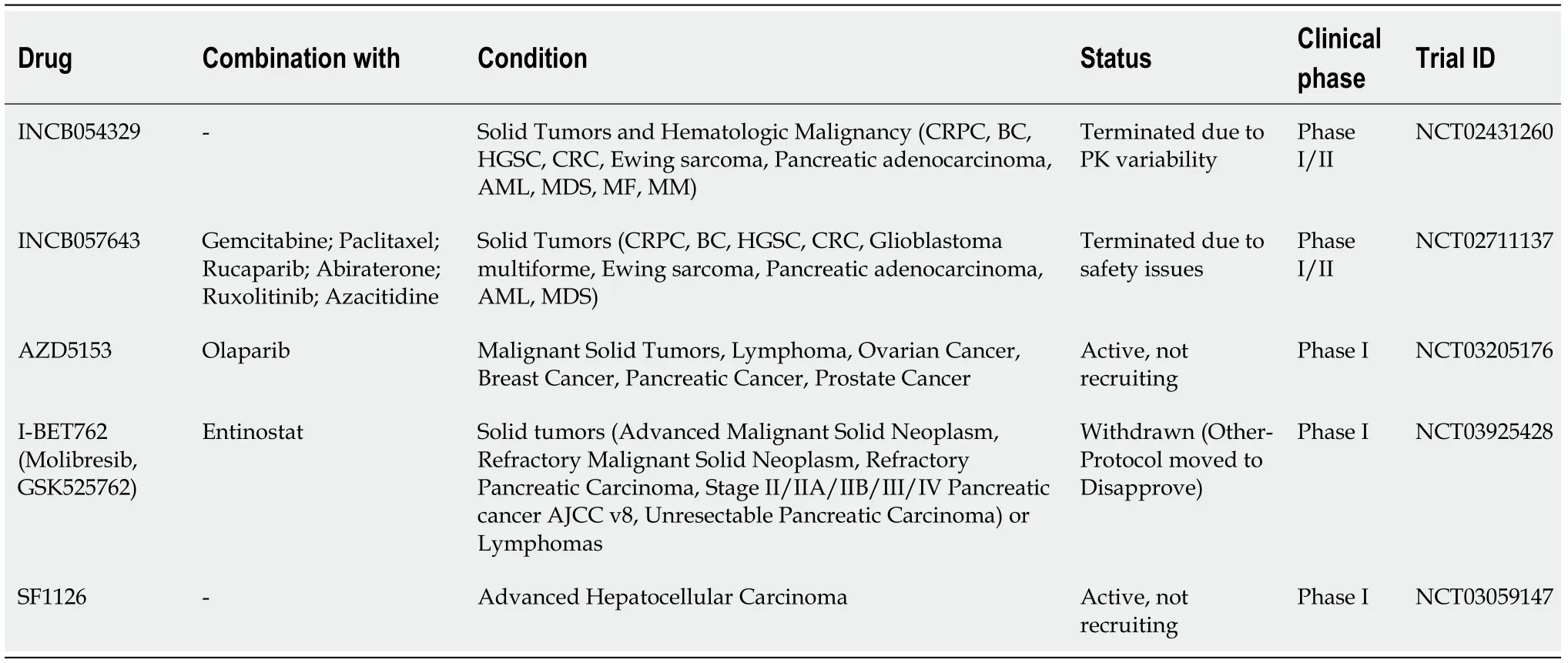
INCB054329 and INCB057643 are two small-molecule BET inhibitors which exhibit anti-cancer activity by reducing the expression level of c-MYC[88,89].Phase I/II doseescalation,safety and tolerability studies of INCB054329 and INCB057643 were conducted in subjects with advanced malignancies including GI cancers.INCB054329 was terminated due to an unfavorable clinical Pharmacokinetic (PK) profile(NCT02431260).INCB057643 compared with INCB054329 has a longer half-life and a shorter PK variability.However,patients received INCB057643 resulted in treatment discontinuance or dose interruption or dose reduction due to TRAEs and the study ultimately terminated in 2020 (NCT02711137).
I-BET762 (Molibresib) is a pan-BET inhibitor that remarkably inhibits the PDAC cell proliferation by down-regulating c-MYC and reducing protein levels of ERK1/2.Remarkably,the anti-tumor effect can be enhanced combined with gemcitabine[87].NCT03925428 is a phase I clinical trial that tests the side effects and best dose of I-BET 762 combined with entinostat in solid tumors or lymphomas advanced or refractory,including PDAC.However,the study was withdrawn because other protocol moved to disapprove.
Presently the Baba Yaga turned toward the wall and began to snore and Vasilissa knew that she was fast asleep. Then she went into the corner, took the tiny doll from her pocket, put before it a bit of bread and a little cabbage soup that she had saved, burst into tears and said: There, my little doll, take it. Eat a little, drink a little, and listen to my grief. Here I am in the house of the old witch and the gate in the wall is locked and I am afraid. She has given me a difficult task and if I do not do all she has bade, she will eat me tomorrow. Tell me: What shall I do?
BET proteins have two BDs with the acetylated lysine binding pocket.Compared with acetylated histones,BDs have a higher affinity for small molecules,which provide new possibilities for the development of inhibitors[18].By occupying the BD pockets,BET inhibitors,such as JQ-1,mimic the binding mode and competitively inhibit binding between acetylated lysines and BDs,resulting in disrupting oncogenic rearrangement and inhibiting the development of some aggressive types of cancer(Figure 2).
JQ-1 exerts an anti-cancer effect on GC as well.Interestingly,JQ-1 has race specificity on GC that Asians rendered more resistance to BET inhibitors than Brazilians[74].Recently,Zhou[75] noted that JQ-1 suppressed proliferation,migration and invasion of GC cellstargeting RUNX2/NID1 axis,while BET inhibitor AZD5153 inhibited GC metastasis by regulating Mus81 at both RNA and protein levels[76].Kim[77] revealed new BRD4 inhibitor that showed efficiency in I-BET762 resistant GC cell lines[77].Additionally,through blocking the expression of c-MYC and YAP1,JQ-1 reduced gastric adenocarcinoma cell growth induced by Gal-3,and the anti-cancer activity could be improved in combination with YAP inhibitors[78].Other combination strategies with chemotherapy drugs have also been reported.The combination of I-BET151 and paclitaxel increased the anti-GC tumor effect than single-treatment[79].Also,JQ-1 synergized with arsenic sulfide targeting c-MYC,exhibits an increasing cytotoxic activity in both gastric and colon cells[52].
BRD3 was rarely studied in GI cancers.However,recently,some frameshift mutations of BRD3 have been found in GC[25].Also,Tan[26] found that BRD3 was among the top six driver genes for familial aggregation of PDAC through wholegenome sequencing.That means unlike BRD2/4,BRD3 may function in GI cancer through a different mechanism.
Dual PI3K/BRD4 Inhibitor SF1126 blocks both the Ras/Raf/MAPK and PI3K/AKT/mTOR pathways and disrupts c-MYC expression as well[90].And a Phase I clinical trial of SF1126 has completed in humans with well toleration and efficacy in solid tumor including CRC[91].Recently,SF1126 is being tested in combination with Nivolumab in patients with advanced HCC and this study is expected to be completed by October 2022 (NCT03059147).
The Caliph, who liked to have old manuscripts in his library, even though he could not read them, purchased the scroll and the box, and dismissed the pedlar
With high bioavailability and biosafety,SF1126 has completed a Phase I clinical study and steps into a Phase II study in advanced HCC.And AZD5153 shows an optimistic preclinical result in GC treatment.All these evidences demonstrate that BET inhibitors constitute a promising field of clinical research in GI cancers.Continued progresses are required especially in exploring rational combinations to open new possibilities for BET inhibitors as anti-GI cancers agents.
CONCLUSION
BET inhibitors have emerged as a new possible strategy for the treatment of GI cancers in recent years.However,either nondurable cytotoxic effects,such as thrombocytopenia and GI disorders[92] or drug resistance make BET inhibitors fail to be administrated as single agents by far.To achieve better selectivity and reduce unwanted toxicities,BET inhibitors continue to be updated,increasing their potential in cancer treatment.
With winter approaching in the tale, it is important to note that polar bears do not hibernate52. According to the World Wildlife Federation53, polar bears are clearly at the top of the food chain, and they ve been known to kill and eat seals, walrus54 and even beluga whales. Standing55 on its hind26 legs, a male polar bear can look an elephant straight in the eye. The polar bear (Ursus maritimus) is the largest terrestrial carnivore. Adult males can measure more than nine feet in length and weigh between 770 to 1,430 pounds (WWF.org). You read more about Polar Bears on the WWF s Polar Bear Page.
The first-generation pan-BET inhibitors have been identified to suppress GI cancer in preclinical results,however,the inevitable side effects limit their clinical applications.Hence,drug discovery efforts concentrate on selectively inhibiting BET proteins[93].Selective BD inhibitors achieved almost equally efficiency in cancer to the pan-BET inhibitors[94] and showed less toxicity[95].A set of selective BD inhibitors help to understand the role of BD in cancers and further focusing on specific BD perturbations may provide more efficiency and tolerability in GI cancers treatment.
Another approach to acquire selective inhibition is to target each BET family members.Since BRD4 is the predominant BET protein that mediates the development of GI cancers,selective BRD4 inhibition may have a better outlook.New BRD4 degraders ARV-825 and A1874 that have already shown their antitumor efficiency in preclinical results support further clinical development of BET inhibitors in GI cancers.
Other strategy to improve the efficacy and pharmacokinetic property of BET inhibitors ismodulating their structure.After modification,these major clinical stage BET inhibitors acquire better tumor killing capacity with minimal ICin multiple solid tumors[96].The optimistic preclinical result makes it possible to treat GI cancer with single agents.
Additionally,synergistic inhibition provides an optimistic prospect for increasing the efficacy of BET inhibitors.The preclinical and clinical results verify high potential in combinational therapy.The resistance to BET inhibitors will be overcome if combined with drugs targeting the pathways that cause resistance[47].Besides,the dosage will be decreased dramatically if combined with drugs rendering GI cancers more sensitive to BET inhibitors[97].Without a doubt,BET inhibitors emerge as a promising avenue for the GI cancers treatment.
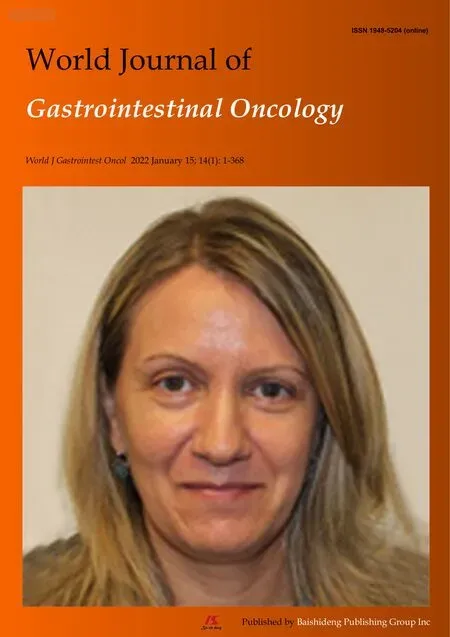 World Journal of Gastrointestinal Oncology2022年1期
World Journal of Gastrointestinal Oncology2022年1期
- World Journal of Gastrointestinal Oncology的其它文章
- Comment on “Outcomes of curative liver resection for hepatocellular carcinoma in patients with cirrhosis”
- Liquid biopsy:Precise diagnosis and therapy for cholangiocarcinoma
- Increased risk of colorectal neoplasia in inflammatory bowel disease patients with post-inflammatory polyps:A systematic review and meta-analysis
- Exosomes as potential diagnosis and treatment for liver cancer
- Effects of cognitive behavior therapy combined with Baduanjin in patients with colorectal cancer
- Intertwined leukocyte balances in tumours and peripheral blood as robust predictors of right and left colorectal cancer survival
